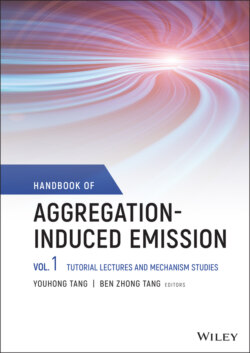Читать книгу Handbook of Aggregation-Induced Emission, Volume 1 - Группа авторов - Страница 21
1.4 Restriction of Access to the Dark State
ОглавлениеRIM serves as the most effective guideline for the design of AIE molecules. However, RIM requires a more detailed elaboration when it is applied to the heteroatom‐containing AIEgens. On the one hand, the introduction of heteroatoms endows the luminogens versatile functions, whereas, on the other hand, it makes the excited‐state features of the luminogens more complicated. First, introduction of heteroatoms, often, produces the electron‐donating or ‐withdrawing effect, and then facilitates the mixing of the overlap‐forbidden charge‐transfer (CT) state with the local‐excited (LE) state. Second, heteroatoms with lone‐pair electrons can import the crossing between the overlap‐forbidden (n,π*) state with the (π,π*) state. What is more, (n,π*) state will facilitate the intersystem crossing from the singlet states to the triplet states, which are spin forbidden and can be easily quenched. All these overlap‐forbidden and spin‐forbidden states have been defined as dark states that are detrimental to the fluorescence process [19].
Taking the (9‐anthrylmethyl) bis(2‐pyridylmethyl) amine (APA) as an example (Figure 1.8) [9], the APA only contains a large π‐conjugation plane consisting of the anthracene and a triple‐pyridine motif, but it shows the unique AIE property, which differs from typical AIEgens, usually, with multiple rotors. Although the APA contains the anthracene with large conjugation, it shows weak UV emission with a ΦF of 0.6% in the dilute tetrahydrofuran (THF) solution with vibronic peaks. After chelation with the zinc ion, it shows enhanced emission with the ΦF of about 100% with the similar vibronic peaks. Meanwhile, with more than 90% water added into the pure solution of APA, the resulting APA aggregate shows a broad and red‐shifted emission band with a peak at 461 nm. The APA crystal also shows a similar emission band at 492 nm. The large spectral variation between the dilute solution and the solid state indicates the mixing of excited states with different characteristics.
Indeed, with optimization of the first two excited states of the isolated APA involving the transition of the lone pair electrons, two kinds of excited‐state features have been figured out. According to the transition characteristics, the two close‐lying excited states are assigned as (π,π*) state and (n,π*) state, which are vibronically coupled by the molecular motions. The bright (π,π*) min owns large oscillator strength and is responsible for the light emission, whereas the lower‐lying (n,π*) min has the oscillator strength nearly close to 0 and crosses the (π,π*) state through the CI, which causes the quenching of the light emission. The key molecular motion connecting these two steady excited‐state points is the rotating of the nitrogen‐containing group. Hence, when chelating with the zinc ion, the lone pair electrons of the nitrogen atoms and the motion of the whole chelating group are blocked, which results in the elevation of the (n,π*) state and recovering of the light emission from the bright (π,π*) state. Similarly, the APA molecules in the crystal can pack tightly to form dimers and stabilized by the intermolecular π–π interaction and multiple C–H interactions, which effectively hinder the rotation of the chelating groups. The lock of lone‐pair electrons and motions of the nitrogen‐containing group lead to the elevation of the dark (n,π*) state and finally boost the fluorescence from the bright (π,π*) state.
Figure 1.8 (a) Illustration of the coupling between the bright state and the dark state by the molecular motion, and the structures at the minimum points of the bright state and the dark state, the emissive chelation complex, and the dimer in the crystal. Schematic potential energy surfaces of RADS related to (b) the chelation with the zinc ion, (c) the dilute solution state, and (d) the dimers in the crystal.
Source: Adapted from Ref. [9] with permission from John Wiley and Sons.
This mechanism can be concluded as the restriction of access to the dark state (RADS), which further elucidates the connotation of the RIM mechanism. The previous investigation mainly focuses on the NAC between the first excited state and the ground state. As an extreme scenario of NAC, the CI can cause ultrafast deactivation. In fact, the PES of multiple excited states can be coupled by molecular motions and arranged in a complicated manner, especially for the heteroatom‐containing molecular systems. The accessible dark states like the CT state, (n,π*) state, and the triplet state will cause the fluorescence quenching. Once the molecular motions that lead to the dark states undergo the intramolecular or environmental constraints, the fluorescence can be restored. The multistate model has been proved effective to evaluate the excited‐state deactivation of the heteroatom‐containing luminogens.
